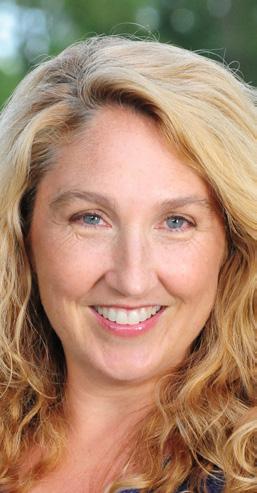
3 minute read
Should You Take Vitamin D?
A recent article by the Cleveland Clinic states that people who are healthy and not undergoing treatments for health problems should not bother taking vitamin D — local experts weigh in
By Deborah Jeanne Sergeant
Advertisement
For years, health experts touted vitamin D as a companion supplement to aid in absorption of bone-strengthening calcium. Vitamin D became a veritable panacea and research linked it to supporting nearly every bodily function and system.
More recently, the importance of vitamin D has been minimized.
A recent article by the Cleveland Clinic stated that people who are healthy and not undergoing treatments for health problems should not bother taking vitamin D.
WebMD cites several research studies in a recent article to show that vitamin D isn’t a superstar supplement, as it does not appear to lower risk of cancer, stroke or heart attack as once thought (although its role in calcium absorption remained intact).

The National Institutes of Health link excessive vitamin D with stomach discomfort, unusual mental symptoms and kidney problems.
“Large-scale studies have found that deficiency is widespread in not just adults but in children as well,” said Laurel Sterling, registered dietitian, certified nutritionist and edu- cator with Carlson Laboratories in Canastota. “Vitamin D has been seen in research with promoting healthy growth and development, supporting teeth, bone and muscle health, assisting with a healthy immune and cardiovascular system as well as aiding in a healthier mood.”
Although vitamin D is important for building bone, Sterling said that bones also need other vitamins and minerals to stay strong.
The body generates vitamin D when exposed to sunlight. However, people in the north experience little exposure to sunlight all winter.
“With some people, the level between June and November is decent, but it falls off between January and April,” said Laura Vreeland, registered dietitian at the Syracuse VA Medical Center.

The only way to know one’s vitamin D levels is lab testing. Vreeland also looks for things like decreased energy and mood during the winter months, even in people with low to normal vitamin D levels. Some of her clients take vitamin D supplements only during the winter months. Others take it all year long, depending upon their health needs.
“Vitamin D is not a set panel for a routine physical,” Vreeland said. “There’s a bit of disparity as to what they recommend for the normal levels between the Endocrine Society and the Institutes of Medicine.”
She encourages people to ask their primary care provider to test their vitamin D level to see if supplementation is needed. Most providers will not bring up vitamin D as part of a routine visit.
Maria Winkworth, registered dietitian, certified nutritionist and owner of Winkworth Wellness in Syracuse, said that getting five to 30 minutes of sunlight several times a week works to spur the body to generate vitamin D, but “if you’re sitting in your house or office near the window, or in your car, you won’t get D that way,” she said. “Window glass blocks UV light. You have to be outside.”


Unfortunately, natural sunlight is hard to come by this time of year. Until spring, seeking supplements and foods rich in vitamin D can help sustain vitamin D levels. Winkworth said that the better form is vitamin D-3, not D-2.
“D-2 is made from plants,” she said. “Most experts recommend D-3 because our bodies absorb and use it better.”
Once you know you need to take vitamin D, “follow up testing eight to 12 weeks after supplementation is suggested to make sure serum levels are improving,” said Julie Mellen, registered dietitian with Upstate Medical University. “If vitamin D stores are normalized, then repeat testing every two to three years is suggested unless there are any major changes in overall health.”
Eat Your Vitamin D?
The daily value for vitamin D is 800 IU (20 mcg). Few naturally occurring food sources of vitamin D-3 exist and most of those are fish. Mushrooms provide only traces of the less helpful D-2 and they are the only vegan, non-supplemental source of either type of vitamin D.
Egg yolk contains 37 IU of vitamin D, although pastured hens may provide three to four times that amount because of their exposure to sunlight. Cod liver oil boasts 450 IU per teaspoon. Canned light tuna offers 269 IU per 3.5-ounce helping.
Try 3.5-ounce servings of these fish for more D-3:
Salmon 526 IU
Fresh Atlantic herring 214 IU
Canned sardines 193 IU
Halibut 190 IU
Mackerel 643 IU
In addition to milk, fortified foods include some brands of breakfast cereal, orange juice and yogurt.
L to R: Maria Winkworth, registered dietitian, certified nutritionist and owner of Winkworth Wellness in Syracuse; Julie Mellen, registered dietitian with Upstate Medical University; Laurel Sterling, registered dietitian, certified nutritionist and educator with Carlson Laboratories in Canastota
Services / Products Available:
n Baseline and monitoring testing for chemotherapy and other hearing – harmful medications n Hearing measurements for personal (medical, communication) or occupational (OSHA, DOT, law enforcement) purposes. n Hearing protection counseling and devices for loud recreational (music listening, hunting, motor sports, landscaping) and occupational (professional musicians, fire and police personnel) activities. n Hearing aid selection, fittings and repairs n Tinnitus evaluations and treatment. n If you have any questions or concerns regarding your hearing how to protect it.










